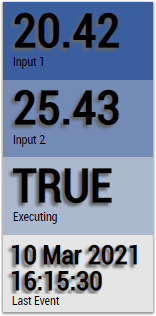Dynamic Time Warping

The Dynamic Time Warping algorithm compares input data with previously recorded templates. The special feature of the algorithm is that signals with different speeds or even shifted signals can be compared. As a result, the distance between the input signal and the respective template is output. The smaller the distance, the more equal the compared signals are. If the distance is 0, both signals are identical. The amount of distance depends on the equality but also on the length of the signals.
The comparison starts when the signal of the Start Period flag is TRUE. A result is output if the signal of the Stop Period flag is TRUE or the Start Period flag is TRUE again.
It is recommended not to use Dynamic time Warping simultaneously with Time Based Teach Path 1Ch due to concurrent file access. Instead, a reference signal should first be taught in with the Time Based Teach Path 1Ch and only then should the evaluation be carried out with the aid of the Dynamic time Warping. The templates contain reference signals previously recorded with the Time Based Teach Path 1Ch. As a rule, the templates are a few hundred supporting points. Therefore, a reduction of the data with the function block Downsampling 1Ch is often useful.
Optionally, a Boolean signal can be selected for the Enable Execution input so that the algorithm is only active if the value of the selected signal is TRUE.
Configuration options
- Num Templates: adds or removes a template for comparison.
- File Path 01 ... n: path to the previously recorded template.
Output values
- Executing Compare: displays TRUE if the algorithm is processing the incoming values, otherwise FALSE. The processing begins when the Start Period flag is TRUE and ends when Stop Period is TRUE.
- Best Match Idx: outputs the index of the template with the smallest distance to the input channel.
- Distance 01 ... n: specifies the distance between the input signal and the respective template. The smaller the distance, the more equal the compared signals are.
Standard HMI Controls
For the Dynamic Time Warping algorithm, the following HMI controls are available for generating an Analytics Dashboard:
1. The Table Control and Multivalue Control visualize all output values: Executing Compare, Best Match Idx, Distance.



Alternatively, customer-specific HMI controls can be mapped in the Dynamic Time Warping algorithm using the Mapping Wizard.